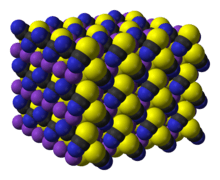Potassium thiocyanate
Potassium thiocyanate is the chemical compound with the molecular formula KSCN. It is an important salt of the thiocyanate anion, one of the pseudohalides. The compound has a low melting point relative to most other inorganic salts.
 | |
| Names | |
|---|---|
| Other names
Potassium sulfocyanate Potassium isothiocyanate Potassium thiocyanide Potassium rhodanide | |
| Identifiers | |
3D model (JSmol) |
|
| ChEBI | |
| ChemSpider | |
| ECHA InfoCard | 100.005.792 |
PubChem CID |
|
| RTECS number |
|
| UNII | |
CompTox Dashboard (EPA) |
|
| |
| |
| Properties | |
| KSCN | |
| Molar mass | 97.181 g mol−1 |
| Appearance | Colorless deliquescent crystals |
| Odor | Odorless |
| Density | 1.886 g/cm3 |
| Melting point | 173.2 °C (343.8 °F; 446.3 K) |
| Boiling point | 500 °C (932 °F; 773 K) (decomposes) |
| 177 g/100 mL (0 °C) 217 g/100 mL (20 °C) | |
| Solubility | acetone: 21.0 g/100 mL ethanol: soluble |
| −48.0·10−6 cm3/mol | |
| Hazards | |
| Safety data sheet | ICSC 1088 |
EU classification (DSD) (outdated) |
Toxic (T) |
| R-phrases (outdated) | R20/21/22 R32 R52/53 |
| S-phrases (outdated) | (S2) S13 S61 |
| NFPA 704 (fire diamond) | |
| Lethal dose or concentration (LD, LC): | |
LD50 (median dose) |
854 mg/kg (oral, rat)[1] |
| Related compounds | |
Other anions |
Potassium cyanate Potassium cyanide |
Other cations |
Sodium thiocyanate Ammonium thiocyanate |
Except where otherwise noted, data are given for materials in their standard state (at 25 °C [77 °F], 100 kPa). | |
| Infobox references | |
Use in chemical synthesis
Aqueous KSCN reacts almost quantitatively with Pb(NO3)2 to give Pb(SCN)2, which has been used to convert acyl chlorides to isothiocyanates.[2]
KSCN converts ethylene carbonate to ethylenesulfide.[3] For this purpose, the KSCN is first melted under vacuum to remove water. In a related reaction, KSCN converts cyclohexene oxide to the corresponding episulfide.[4]
- C6H10O + KSCN → C6H10S + KOCN
KSCN is also the starting product for the synthesis of carbonyl sulfide.
Other uses
Dilute aqueous KSCN is occasionally used for moderately realistic blood effects in film and theater. It can be painted onto a surface or kept as a colorless solution. When in contact with ferric chloride solution (or other solutions containing Fe3+), the product of the reaction is a solution with a blood red colour, due to the formation of the thiocyanatoiron complex ion. Thus this chemical is often used to create the effect of 'stigmata'. Because both solutions are colorless, they can be placed separately on each hand. When the hands are brought into contact, the solutions react and the effect looks remarkably like stigmata.
Similarly, this reaction is used as a test for Fe3+ in the laboratory.
References
- Chambers, Michael. "ChemIDplus - 333-20-0 - ZNNZYHKDIALBAK-UHFFFAOYSA-M - Potassium thiocyanate [NF] - Similar structures search, synonyms, formulas, resource links, and other chemical information". chem.sis.nlm.nih.gov. Retrieved 19 April 2018.
- Smith, P. A. S.; Kan, R. O. (1973). "2a-Thiohomophthalimide". Organic Syntheses.CS1 maint: multiple names: authors list (link); Collective Volume, 5, p. 1051
- Searles, S.; Lutz, E. F.; Hays, H. R.; Mortensen, H. E. (1973). "Ethylenesulfide". Organic Syntheses.CS1 maint: multiple names: authors list (link); Collective Volume, 5, p. 562
- van Tamelen, E. E. (1963). "Cyclohexenesulfide". Organic Syntheses.; Collective Volume, 4, p. 232
